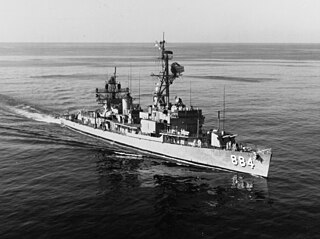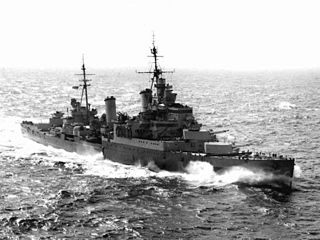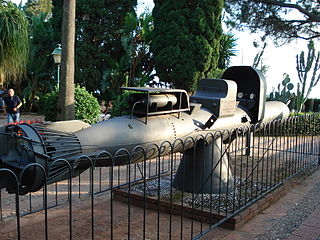
The RMS Queen Elizabeth was an ocean liner operated by Cunard Line. With Queen Mary she provided weekly luxury liner service between Southampton in the United Kingdom and New York City in the United States, via Cherbourg in France.

USS Albany (CA-123) was a United States Navy Oregon City-class heavy cruiser, later converted to the guided missile cruiser CG-10. The converted cruiser was the lead ship of the new Albany guided missile cruiser class. She was the fourth ship to carry the name Albany.

HMS Queen Elizabeth was the lead ship of her class of five dreadnought battleships built for the Royal Navy in the early 1910s, and was often used as a flagship. She served in the First World War as part of the Grand Fleet, and participated in the inconclusive action of 19 August 1916. Her service during the war generally consisted of routine patrols and training in the North Sea. She and the other super-dreadnought battleships were the first of their type to be powered by oil instead of coal. Queen Elizabeth later served in several theatres during the Second World War, and was scrapped in 1948.

Regele Ferdinand (F221) is a Type 22 frigate of the Romanian Naval Forces, formerly a Royal Navy ship named HMS Coventry (F98). She was originally intended to be named Boadicea but was named Coventry in honour of the previous Coventry, a Type 42 destroyer sunk in the Falklands War. Following service in the Royal Navy she was sold to the Romanian Navy in 2003.

USS Floyd B. Parks (DD-884) was a Gearing-class destroyer in service with the United States Navy from 1945 to 1973. She was scrapped in 1974.

USS Charles R. Ware (DD-865), was a Gearing-class destroyer of the United States Navy in service from 1945 to 1974. After her decommissioning, she was sunk as a target in 1981.

USS Ludlow (DD-112) was a Wickes-class destroyer built for the United States Navy during World War I.

The United States Congress authorized the original six frigates of the United States Navy with the Naval Act of 1794 on March 27, 1794, at a total cost of $688,888.82. These ships were built during the formative years of the United States Navy, on the recommendation of designer Joshua Humphreys for a fleet of frigates powerful enough to engage any frigates of the French or British navies, yet fast enough to evade any ship of the line.

USS Hammerberg (DE-1015), a Dealey-class destroyer escort, was a ship of the United States Navy named for Navy diver Francis P. Hammerberg (1920–1945), of Flint, Michigan, who was awarded the Medal of Honor posthumously for rescuing two fellow divers from a wreck in Pearl Harbor.

HMS Sheffield was one of the Southampton sub class of the Town-class cruisers of the Royal Navy during the Second World War. She took part in actions against several major German warships. Unlike most Royal Navy ships of her time, her fittings were constructed from stainless steel instead of the more traditional brass. This was an attempt to reduce the amount of cleaning required on the part of the crew. Her nickname, the "Shiny Sheff", stemmed from this. A prototype radar system was placed into service in August 1938 on the Sheffield. It was the first vessel in the Royal Navy to be so equipped.

USS Henley (DD-762), an Allen M. Sumner-class destroyer, was the fourth ship of the United States Navy to be named Henley, was named after Captain Robert Henley ; an officer in the United States Navy during the Quasi-War with France, the War of 1812 and the Second Barbary War.

USS Solar (DE-221), a Buckley-class destroyer escort of the United States Navy, was named in honor of Boatswain's Mate First Class Adolfo Solar (1900–1941), who was killed in action during the Japanese attack on Pearl Harbor on 7 December 1941.
German submarine U-221 was a Type VIIC U-boat of Nazi Germany's Kriegsmarine during World War II.

USS Kenmore (AP-162/AK-221) was a Crater-class cargo ship built during World War II for the US Navy. Kenmore was named after George Washington's sister Betty's house Kenmore. Kenmore was responsible for delivering troops, goods and equipment to locations in the Asiatic-Pacific Theater.
USS Diploma (AM-221) was an Admirable-class minesweeper built for the United States Navy during World War II. She was awarded three battle stars for service in the Pacific during World War II. She was decommissioned in September 1946 and placed in reserve. While she remained in reserve, Diploma was reclassified as MSF-221 in February 1955 but never reactivated. In 1962, she was sold to the Mexican Navy and renamed ARM DM-17. In 1994 she was renamed ARM Cadete Francisco Márquez (C59). She was stricken in 2000, but her ultimate fate is not reported in secondary sources.

USS Portunus (ARC-1) was an LSM-1-class landing ship medium acquired by the U.S. Navy for use during World War II as a landing craft for troops, and later, as a cable repair ship.

USS Oneida (APA-221) was a Haskell-class attack transport in service with the United States Navy from 1944 to 1946. She was scrapped in 1975.

USS Tracer (AGR-15) was a Guardian-class radar picket ship, converted from a Liberty Ship, acquired by the US Navy in 1957. She was reconfigured as a radar picket ship and assigned to radar picket duty in the North Pacific Ocean as part of the Distant Early Warning Line.

The Raid on Alexandria was carried out on 19 December 1941 by Italian Navy divers of the Decima Flottiglia MAS, who attacked and disabled two Royal Navy battleships in the harbour of Alexandria, Egypt, using manned torpedoes.

SAS Somerset was a Bar-class boom defence vessel of the South African Navy, now preserved as a museum ship in Cape Town. Formerly HMS Barcross, it operated in Saldanha Bay, transferred to South Africa Naval Forces during World War II and was purchased by South Africa in 1947.

















